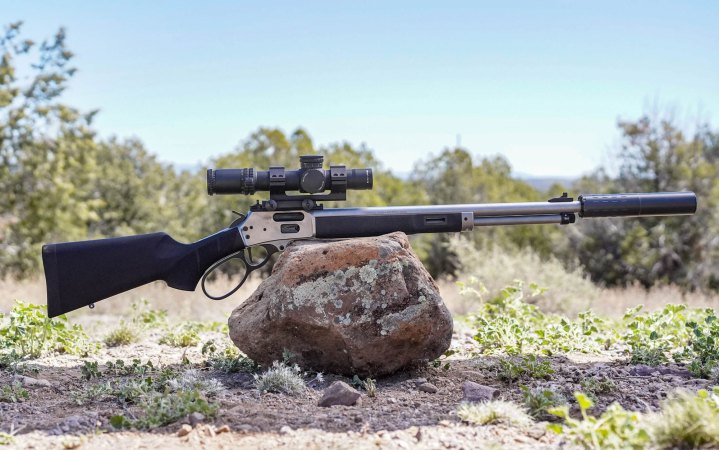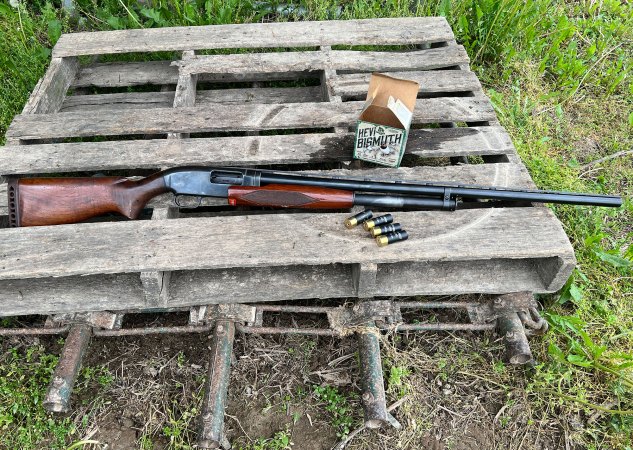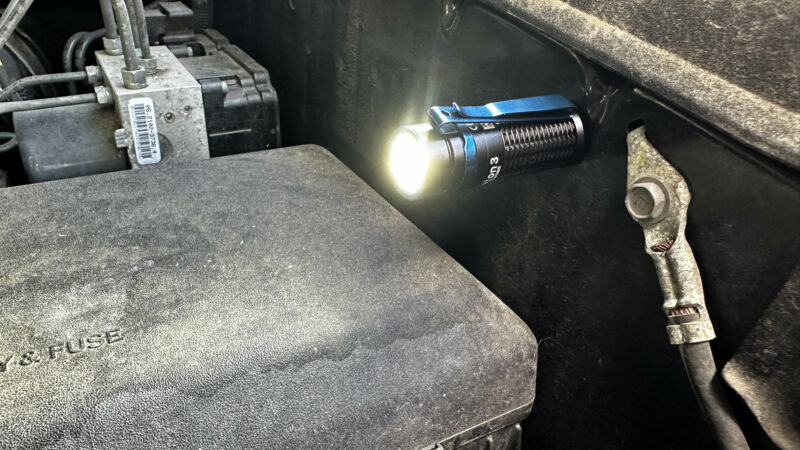Smith & Wesson Model 1854 Review: There’s a New Powerhouse in the Lever Action World
We may earn revenue from the products available on this page and participate in affiliate programs. Learn More ›
In my eyes the Smith & Wesson Model 1854 is the most remarkable new rifle of the year. Perhaps you were blessed with a crystal ball, but I certainly didn’t have a Smith & Wesson lever action on my bingo card for 2024. What makes this accomplishment so impressive is that they got it wonderfully right when there are so many ways it could have gone terribly wrong.
First off, let’s recognize that the Model 1854 is incredibly well executed. I’ll dig into the details in a bit, but the Smith & Wesson 1854 checks every box I like to see in a new rifle. It serves a clear purpose — an all-weather close-range hunting rifle — and incorporates nearly all the features any person wielding it could want. It exhibits excellent craftsmanship and gets high marks for its fit and finish, ergonomics, and smooth operation. And — the cherry on top — it represents a very good value.
It might seem like a given to expect all this from any new gun, and that’s a fair point. But that Smith & Wesson was able to do this while venturing into terra incognita — this is their first lever action — increases the chance that something might go awry. We’ve seen this plenty of times over the years, including from Smith & Wesson itself with the ill-fated i-Bolt that it trotted out a dozen years ago. That series was a colossal flop.
Lastly, they pulled this off while manufacturing a lever action, a platform that is notoriously tricky to perfect. The complex interplay of parts in a lever gun can go sideways on you before you know it. This was a key reason that Marlin fell on its face when it was purchased by the Remington Outdoor Company in 2007.
The dimwitted executives that made the purchase thought they could relocate Marlin’s machinery from North Haven, Conn., to Ilion, N.Y. and keep churning out 336s and 1895s. Plenty of people cautioned them against that move, but they ignored that counsel with sadly predictable results.
In a nutshell, this is why I’m so impressed with the S&W 1854. It’s a testament to the skill and vision of the engineers, designers, and everyone else who had a hand in bringing it to fruition.
It also dramatically changes the lever-action landscape. For the last few years Marlin and Henry Repeating Arms have been the dominant source for readily available high-quality lever guns. With the Model 1854, Smith & Wesson has shown there’s a new player in town — and the main beneficiary will be hunters and shooters who now have more choices to pick from.
Smith & Wesson Model 1854 Specs
- Action: Lever
- Cartridge: .44 Rem. Mag./.44 Spl. (tested)
- Capacity: 10
- Barrel: 19.25 inches, threaded 11/16-24, 1:20 twist
- Length: 36 inches
- Weight: 6 pounds, 12 ounces (measured)
- Trigger: 4 pounds, 7 ounces (measured)
- Stock: Synthetic
- Sights: Ghost ring with Picatinny rail
- Price: $1,279
Key Features
- All-weather construction
- Forend comes with M-Lok attachments
- Has Picatinnay rail for mounting optics
- Comes with oversized lever loop
- Rifle unloads via magazine tube
Review Highlights
- Loads, cycles, and shoots easily
- Balances and carries well
- Excellent trigger for a lever action
- Accuracy: 1.800-inch average 5-shot group at 50 yards, with a total of 30 groups and six different types of ammo
Smith & Wesson 1854 Configuration
The Model 1854 is a smart combination of traditional and modern features that harmonize in a useful and fun rifle. Chambered in .44 Magnum it can also run .44 Specials, and between these two cartridges there are plenty of types of ammo to choose from — everything from mild cowboy-action plinking rounds to smashers designed to stop a charging bear.
Easy Loader
The rifle holds 10 rounds and loads through a side gate and is engineered so you can unload it through the magazine tube by removing the spring and plunger assembly, which is very handy. You just tip the rifle forward and the rounds spill out of the tube. Note, that you can’t load the rifle this way. But that’s not a drawback because like
other components on the rifle, the loading gate operates smoothly making it easy to top off the rifle without worrying about the gate catching your fingers.
Another indication of the rifle’s quality workmanship is how the rounds always stayed put in the magazine while loading and squirted back onto the carrier, which is a relatively common occurrence with lever guns.
The muzzle is also threaded so that you can easily attach a suppressor, which is how we did most of our shooting with the 1854. One minor consideration here is that when you have a suppressor on board, you can’t unload the magazine because the tube becomes blocked by the can.
Useful Stock
The silhouette of the rifle captures the traditional lines of a lever action. But Smith equipped this version with a synthetic stock that will stand up to lots of abuse, and can accept accessories thanks to M-Lok slots molded into the forend. This allows the rifle to accommodate rails for accessories, like lights, lasers, and other items commonly used on tactical lever actions.
The Model 1854 has a Picatinny rail on top of the receiver and makes mounting a scope like an LPVO an appealing option. We did that ourselves and it was with a scope on board that we gathered our accuracy data. (The rifle comes with good ghost-ring sights that are serviceable out to 75 yards, so a scope isn’t an absolute necessity.)
The accuracy of our sample was pretty good, and we were certainly satisfied with the results. We got our data shooting it off a support bag on a tripod at 50 yards. Another thing that stood out during the evaluation was how the rifle digested all manner of ammunition without any hiccups.
Because the butt stock has a fair amount of drop, the shooter’s head lines up behind the open sights. With the irons or a red-dot/reflex sight mounted low on the receiver this isn’t an issue. However, if you run a scope you might consider an aftermarket cheek pad that gets your head higher on the stock to align the eye better with the optic.
Excellent Trigger
The trigger on the 1854 is the best we’ve seen on a regular production lever action. It has a flat face like a competition trigger, which is a bit of a curious choice, but the trigger break is extremely clean, has very little take-up, and no perceptible creep.
Running the Smith & Wesson Model 1854
Combine the good trigger, smooth action, and good sights in a lever gun and you have the makings of a shooter. The Smith is able to get a lot of lead downrange quickly and accurately.
The recoil pad has generous cushioning so all the loads we ran were manageable and the rifle was easy to control.
The lever loop was machined without rough edges so when running the rifle hard it was never uncomfortable.
The Smith & Wesson Model 1854 has a cross-bolt safety similar to what you see on Marlins. I prefer my lever actions without this feature, which is what Henry does, having the hammer indicate the status of the rifle — cocked back for “fire” and down for “safe.”
Pros and Cons
This is a capable, affordable, reliable, and comfortable rifle that balances how a lever-action should and is quick to the shoulder and quick on target. It really has no shortcomings.
The only quibbles — and these are minor — are the shape of the trigger that might feel better with a curved face, and the need for a higher comb when the rifle has a scope on board. Perhaps a modular butt stock in some future iteration can address this.
Final Thoughts on the Smith & Wesson Model 1854
This lever action is a hell of a rifle. Smith and Wesson has created a lever gun that will work well on deer, hogs, bear, and any other close-quarters game. It’s rugged enough to serve as a truck gun, will ride well in a scabbard, and is a potent option for personal protection, especially in jurisdictions that restrict ARs and other semi autos.
The M1854 heralds a new, and exciting, era for one of our most beloved gun makers, and demonstrates why lever actions hold continuing appeal for American shooters and hunters.
The post Smith & Wesson Model 1854 Review: There’s a New Powerhouse in the Lever Action World appeared first on Outdoor Life.
Source: https://www.outdoorlife.com/guns/smith-and-wesson-1854-review/








